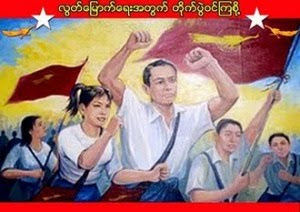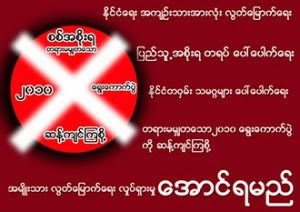“Everyone is entitled to a social and international order in which rights and freedoms set forth in the Declaration can be fully realized” ..... (Article 28, Universal Declaration of Human Rights)
According to the universal Declaration of Human Rights, 52 millions of people are entitled to an international order for their freedom and civil and political rights. They have been living under the military regime in a situation where injustice becomes law. Otherwise, they have been under the international criminals for more than four decades. Now it should be a time to call the international community to be brought Burma’s case to the attention of International Criminals Court (ICC).
On 17 July 1998, 120 nations voted to adopt the Rome Statue of International Criminal Court (ICC). Four years later, this statue entered into force. The ICC is established as a permanent court with complementary back up jurisdiction, located in The Hague, the Netherlands. The international Criminal Court composed of four organs, i.e.
(a) The Presidency
(b) The Chambers
(c) The office of the Prosecutor and
(d) The Registry.
In general, the court has jurisdiction with respect to the four types of crimes.
The crime of genocide
Crimes against humanity
War Crimes
The Crime of aggression.
Among them, the crime of genocide and crimes against humanity were committed by the current military regime of Burma on a national scale.
For Genocide, Article 6 of Rome Statue repeated the Article 2 of the Genocide Convention, i.e.
“any of the following acts committed with intent to destroy, in whole or in part, a national, ethnical, racial or religious group, as such:
(a) Killing members of the group;
(b) Causing serious bodily or mental harm to members of the group;
(c) Deliberately inflicting on the group conditions of life calculated to bring about its physical destruction in whole or in part;
(d) Imposing measures intended to prevent births within the group;
(e) Forcibly transferring children of the group to another group”
For Crimes against humanity, Article 7 of Rome Statue defined as _
“Any of the acts when committed as part of a widespread or systematic attack directed against any civilian population, with knowledge of attack:
(a) Murder;
(b) Extermination
(c) Enslavement
(d) Deportation or forcible transfer of population
(e) Imprisonment or other severe deprivation of physical liberty in violation of fundamental rules of international law;
(f) Torture
(g) Rape, sexual slavery, enforced prostitution, forced pregnancy, enforced sterilization, or any other form of sexual violence of comparable gravity
(h) Persecution against any identifiable group or collective on political, racial, national, ethnic, cultural, religious, gender
(i) Enforced disappearance of persons;
(j) The crime of apartheid
(k) Other inhuman acts of a similar character intentionally causing great suffering, or serious
injury to body or to mental or physical health.
Undoubtedly, it is clear that the current officials from military regime have committed these crimes with mens rea (i.e. intentionally, and with knowledge of the likely consequences) because genocide and crimes against humanity were used as the weapons of war against the ethnic minorities and members of the opposition groups. These were well documented in the reports of
“School for Rape: The Burmese Military and Sexual Violence” by Earth Rights international (1998)
“License to Rape” by Shan Women Actions Network (2002)
“System of Impunity: Nationwide patterns of Sexual Violence by the Military Regime’s Army and Authorities in Burma” by Women’s League of Burma (2004)
“ A Land Without Evil: Stopping the Genocide of Burma’s Karen People”; by Rogers, Ben (2004)
“ Dying Alive: A legal Assessment of the Human Rights Violations in Burma”, by Horton, Guy (2005)
“Saving Lives, Enriching Life” Pg.18-22 by Rummel, R. (2001); and so on.
The most direct mechanism for triggering the power to investigate these international crimes is under Article 13(b), where by a ‘situation’ is referred to the prosecutor by the Security Council acting pursuant to Chapter VII of the UN Charter. The Court cannot acquire jurisdiction without the Security Council resolution unless the conduct in question occurred on the territory of a state which is party to the Statue or else suspect is a national of a state which is party to the Statue.
Alternatively, the prosecutor may initiate investigations ‘proprio motu’ (on his own or her initiative) and seek evidences from states, UN agencies and other reliable resources. In this case, a pre-trial division of the Court must examine the evidence, hear jurisdiction objection, and decide whether to authorize ‘the commencement of the investigation’. The prosecutor’s special investigative powers cannot be engaged unless or until the pre-trial division rules that there is a prima facie case, ‘a reasonable bias to proceed’
The ICC can issue a warrant for arrest if the prosecutor demonstrates ‘reasonable grounds to believe’ complicity in crime. Suspects must be transported to The Hague and surrendered into the custody of the court.
In conclusion, I would like to appeal to UN Security Council to put Burma issues in an agenda and refer to the prosecutor of International Criminal Court to precede the legal actions against the criminal officials of SPDC regime.
Khin Ma Ma Myo
(9/04/2006)
References:
Robertson, G. (1999) Crimes against Humanity: The Struggle for Global Justice, Penguin, London
Steiner, H. & Alston, P. (2000) International Human Rights in Context: Law, Politics, Morals, Oxford University Press, Oxford
Arsanjani, M. & Reisman, W. (2005) The Law- in-Action of the International Criminal Court, The American Journal of International Law, vol 99, No.2, pp.385-403
Racsmany, Z. (2001) The Nationality of the offender and the Jurisdiction of the International Criminal Court, The American Journal of International Law, vol.95, No.3, pp. 606-623
Verdross-Drossberg, A.(1949) Void and punishable Acts of state in International Law, The Western Political Quarterly, vol. 2, No.2, pp.183-192, university of Vienna Law School
Robertson, G. (1999) Crimes against Humanity: The Struggle for Global Justice, Penguin, London
Steiner, H. & Alston, P. (2000) International Human Rights in Context: Law, Politics, Morals, Oxford University Press, Oxford
Arsanjani, M. & Reisman, W. (2005) The Law- in-Action of the International Criminal Court, The American Journal of International Law, vol 99, No.2, pp.385-403
Racsmany, Z. (2001) The Nationality of the offender and the Jurisdiction of the International Criminal Court, The American Journal of International Law, vol.95, No.3, pp. 606-623
Verdross-Drossberg, A.(1949) Void and punishable Acts of state in International Law, The Western Political Quarterly, vol. 2, No.2, pp.183-192, university of Vienna Law School


































